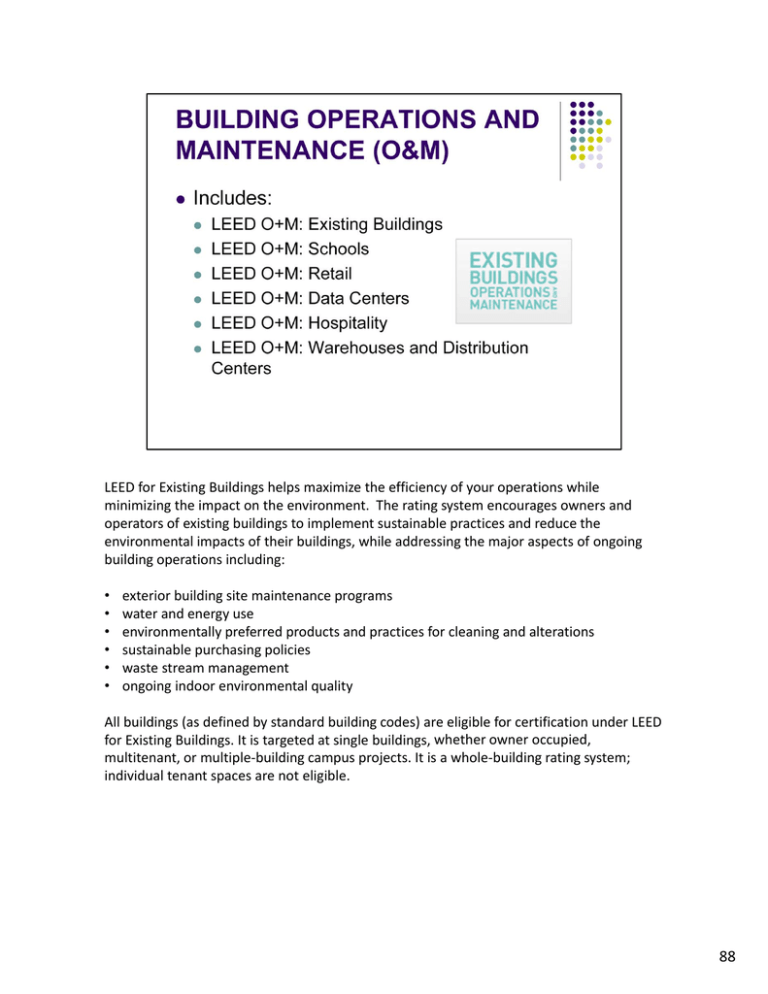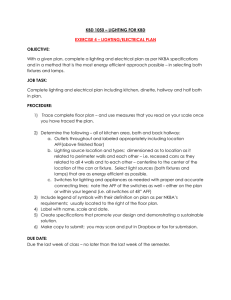Existing Buildings
advertisement

LEED for Existing Buildings helps maximize the efficiency of your operations while minimizing the impact on the environment. The rating system encourages owners and operators of existing buildings to implement sustainable practices and reduce the environmental impacts of their buildings, while addressing the major aspects of ongoing building operations including: • • • • • • exterior building site maintenance programs water and energy use environmentally preferred products and practices for cleaning and alterations sustainable purchasing policies waste stream management ongoing indoor environmental quality All buildings (as defined by standard building codes) are eligible for certification under LEED for Existing Buildings. It is targeted at single buildings, whether owner occupied, multitenant, or multiple‐building campus projects. It is a whole‐building rating system; individual tenant spaces are not eligible. 88 Sustainable sites credits encourage strategies that minimize the impact on ecosystems and water resources. Within O&M we will look at only the one credit on light pollution reduction 89 This credit requires compliance with one of the following: 1. Either Shield all exterior fixtures (where the sum of the mean lamp lumens for that fixture exceeds 2,500) such that the installed fixtures do not directly emit any light at a vertical angle more than 90 degrees from straight down. OR 2. Measure the night illumination levels at regularly spaced points on the project boundary, taking the measurements with the building’s exterior and site lights both on and off. At least eight measurements are required, at a maximum spacing of 100 feet (30 meters) apart. The illumination level measured with the lights on must not be more than 20% above the level measured with the lights off. 90 Energy & atmosphere credits promote better building energy performance and offer the greatest opportunity for points. 91 For all O&M projects other than Data Centers, this prerequisite is to conduct an energy audit that meets both the requirements of the ASHRAE preliminary energy use analysis and an ASHRAE Level 1 walk‐through assessment identified in the ASHRAE Procedures for Commercial Building Energy Audits or equivalent. Also, a current facilities requirements and operations and maintenance plan must be developed. This plan must include setpoints for lighting levels throughout the building. For Data Centers, the project must, instead, use the U.S. Department of Energy’s DC PRO Profiling Tool to perform a preliminary assessment of energy consumption in data center spaces for critical systems. 92 Requirements for this prerequisite include: 1. The calibration of meters within the manufacturer’s recommended interval if the building owner, management organization, or tenant owns the meter. Meters owned by third parties (e.g., utilities or governments) are exempt. AND 2. Meter the building’s energy use for a full 12 months of continuous operation and achieve the levels of efficiency set forth in appropriate case. Each building’s energy performance must be based on actual metered energy consumption for both the LEED project building(s) and all comparable buildings used for the benchmark. This requirement has 2 cases; they cover projects that are and are not eligible for an Energy Star rating. 93 The requirements here include: 1. Install new or use existing building‐level energy meters or sub‐meters that can be aggregated to provide building‐level data representing total building energy consumption (electricity, natural gas, chilled water, steam, fuel oil, propane, etc.). Utility‐owned meters capable of aggregating building‐level resource use are acceptable. 2. Compile meter data into monthly and annual summaries; meter readings can be manual or automated. 3. Commit to sharing with USGBC the resulting energy consumption data and electrical demand data (if metered) for a five‐year period beginning on the date the project accepts LEED certification or typical occupancy, whichever comes first. At a minimum, energy consumption must be tracked at one‐month intervals. This commitment must carry forward for five years or until the building changes ownership or lessee. 94 This credit has basically the same structure as its associated prerequisite and points are earned based on improvement over performance at that prerequisite level. 95 We can see here that USGBC has significantly beefed up the materials based criteria in v4 and lighting plays a larger role than in previous versions. 96 This prerequisite requires that the project have in place an environmentally preferable purchasing (EPP) policy for products purchased during regular operations of the building. This includes the purchase of lamps in accordance with the next credit. The project must also establish safe storage areas and disposal methods for batteries and mercury‐containing lamps. Retail projects have an additional requirement that involves doing one of the following: 1. Establish a supply chain survey, OR 2. Establish a program to inform employees and tenants engaged in merchandise purchasing, packaging, and distribution about environmentally preferable supply chain strategies., OR 3. Establish criteria for retail products encouraging an environmentally preferable supply chain strategy, OR 4. Install an educational program display for customers displaying environmental initiatives that the store has implemented. 97 This credit involves implementing a lighting purchasing plan that specifies an overall building average of 70 picograms of mercury per lumen‐hour or less for all mercury‐ containing lamps purchased for the building and associated grounds within the project boundary. Include lamps for both indoor and outdoor fixtures, as well as both hard‐wired and portable fixtures. Lamps containing no mercury may be counted only if their energy efficiency at least equals that of their mercury‐containing counterparts. 98 This credit calls for the project to maintain a waste reduction and recycling program that reuses, recycles, or composts the following: 1. at least 50% of the ongoing waste as specified in Materials and Resources Prerequisite: Ongoing Purchasing and Waste Policy (by weight or volume); and 2. at least 75% of the durable goods waste as specified in Materials and Resources Prerequisite: Ongoing Purchasing and Waste Policy (by weight, volume or replacement value). In addition, safely dispose of all discarded batteries and all mercury‐containing lamps. School projects have additional requirements regarding food waste. ‐ XXX 99 Indoor environmental quality credits promote better indoor air quality and access to daylight and views. 100 First, for 1 point, the project must, for at least 50% of individual occupant spaces, have in place individual lighting controls that enable occupants to adjust the lighting to suit their individual tasks and preferences, with at least three lighting levels or scenes (on, off, midlevel). Midlevel is 30% to 70% of the maximum illumination level (not including daylight contributions). ========================================================================== ======== For all shared multi‐occupant spaces, meet all of the following requirements. 1. Have in place multi‐zone control systems that enable occupants to adjust the lighting to meet group needs and preferences, with at least three lighting levels or scenes (on, off, midlevel). 2. Lighting for any presentation or projection wall must be separately controlled. 3. Switches or manual controls must be located in the same space as the controlled luminaires. A person operating the controls must have a direct line of sight to the controlled luminaires. In hospitality/O&M projects, guest rooms are assumed to have adequate lighting controls and are therefore not included in the credit calculations. ========================================================================== ========== For a second point, the lighting design must use 4 of the following strategies: A. For all regularly occupied spaces, have in place light fixtures with a luminance of less than 2,500cd/sq. meter between 45 and 90 degrees from nadir. Exceptions include 101 wallwash fixtures properly aimed at walls, as specified by manufacturer’s data, indirect uplighting fixtures, provided there is no view down into these uplights from a regularly occupied space above, and any other specific applications (i.e. adjustable fixtures). B. For the entire project, have in place light sources with a CRI of 80 or higher. Exceptions include lamps or fixtures specifically designed to provide colored lighting for effect, site lighting, or other special use. C. For at least 75% of the total connected lighting load, have in place light sources that have a rated life (or L70 for LED sources) of at least 24,000 hours (at 3‐hour per start, if applicable). D. Have in place direct‐only overhead lighting for 25% or less of the total connected lighting load for all regularly occupied spaces. E. For at least 90% of the regularly occupied floor area, meet or exceed the following thresholds for area‐weighted average surface reflectance: 85% for ceilings, 60% for walls, and 25% for floors. F. Meet or exceed the following thresholds for area‐weighted average surface reflectance: 45% for work surfaces and 50% for movable partitions. G. For at least 75% of the regularly occupied floor area, meet an average ratio of wall surface illuminance (excluding fenestration) to average work surface illuminance that does not exceed 1:10. Must also meet strategy E, strategy F, or demonstrate area‐weighted surface reflectance of at least 60% for walls. H. For at least 75% of the regularly occupied floor area, meet an average ratio of ceiling illuminance (excluding fenestration) to work surface illuminance that does not exceed 1:10. Must also meet strategy E, strategy F, or demonstrate area‐weighted surface reflectance of at least 85% for ceilings. 101 The first 2 points of this credit come from confirming through measurement that the site achieves illuminance levels between 300 lux and 3,000 lux for at least 50% of the regularly occupied floor area. For the next 2 points, achieve a direct line of sight to the outdoors via vision glazing for 50% of all regularly occupied floor area. Additionally, 50% of all regularly occupied floor area must have at least two of the following four kinds of views: 1. multiple lines of sight to vision glazing in different directions at least 90 degrees apart; 2. views that include at least two of the following: (1) flora, fauna, or sky; (2) movement; and (3) objects at least 25 feet (7.5 meters) from the exterior of the glazing; 3. unobstructed views located within the distance of three times the head height of the vision glazing; and 4. views with a view factor of 3 or greater, as defined in “Windows and Offices; A Study of Office Worker Performance and the Indoor Environment.” Include in the calculations any permanent interior obstructions (e.g., lab hoods, fixed partitions, demountable opaque full‐ or partial‐height partitions). Movable furniture and partitions may be excluded. Views into interior atria may be used to meet up to 30% of the required area. 102 The office portion of warehouses and distribution centers must meet the requirements just stated. But areas used for the bulk storage, sorting, and distribution must meet the requirements above for 25% of the regularly occupied floor area. 102 For this credit, the project must administer at least one occupant comfort survey to collect anonymous responses regarding at least the following: • acoustics; • building cleanliness; • indoor air quality; • lighting; and • thermal comfort. The responses must be collected from a representative sample of building occupants making up at least 30% of the total occupants. Document survey results and then develop and implement a corrective action plan to address comfort issues if the results indicate that more than 20% of occupants are dissatisfied. Perform at least one survey and implement corrective actions. At a minimum, perform one new survey at least once every 2 years. 103



